Venomous Snakes of Costa Rica
By Manuel Cabalceta Mendéz, Professional Rainforest Guide
[email protected], www.manuelstours.com, 8719-6195
Translation by Brian Schoenholtz
[email protected], (630) 760-8017, (505) 8616-4365
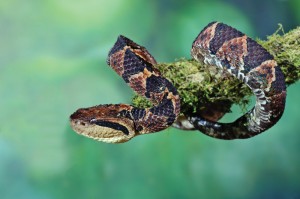
Among reptiles, snakes are the most adaptive group and there are an estimated 2,900 species in the world. In Costa Rica, there are 139 species of snakes, representing 60% of the reptiles of the country. 22 species are venomous and the remaining 117 species are non-venomous. Snakes are found in almost all regions of Costa Rica, including the low lands, volcanic slopes, and even as high as 9,000 feet on mountain ridges.
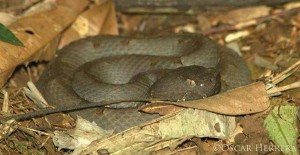
Some snakes are exclusively terrestrial, like the famous Fer-de-Lance (aka Terciopelo, Black Velvet), the Rattlesnake, the Bushmaster, etc. In addition, there are snakes that are arboreal, including the Eyelash Palm Pit Viper, the Side-Striped Palm Pit Viper, etc. Snakes play an important role in helping to control rodent populations and their existence is important in nature’s ecosystem. Some snakes, such as Zopilota (clelia sp.), feed on their venomous counterparts.
Instance in Costa Rica
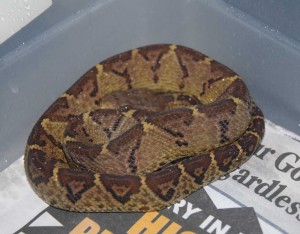
On average, Costa Rica has an estimated 500 snake bites per year, and less than 1% of those are fatal. Since the creation of the national anti-ophidian serum in 1966, and the founding of Clodomiro Picado institute in April 1970 (the only entity producing anti venom in Costa Rica), the decline in mortality from accidents with snakes has been considerable. There is adequate anti venom supply in most of the national health system and special snake bite response training has been implemented in the health care sector.
As to the anatomical site of bites, an estimated 50% of cases occur in the feet and 30% occur in the upper extremities. A much smaller percentage of accidents occur in the head and trunk. Snakes do not attack humans as popularly believed, and will only strike if they feel threatened or provoked.
Prevention
To prevent an ophidical accident a person should adhere to the following recommendations:
- Use rubber or leather boots.
- Be careful when inserting hands into holes, under rocks, around branches and when collecting fruits.
- If you find a snake, simply back away and do not manipulate it.
- Use an instrument to remove weeds, logs, or stones if necessary.

What to do
If bitten, it is recommended to immobilize the affected limb, stay calm, call 911 and take the person immediately to the nearest health center.
DO NOT:
- Do not use tourniquet or ligatures.
- Do not try to suck out the venom by mouth.
- Do not make cuts.
- Do not use home remedies such as creams, herbs, ice, or any other chemical.
When identifying poisonous snakes, professionals observe certain morphological characteristics as:
- Shape of head.
- Presence or absence of neck.
- Vertically elliptical pupils.
- The shape of the tail
- Loreal pits
The Costa Rican venomous snakes are divided into two families.
FAMILY ELAPIDAE (Corals and Sea Snakes)
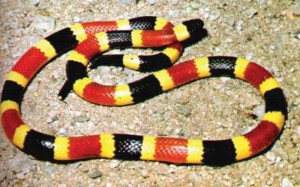
Elapidae are characterized by having smooth scales and their head does not stand out from the body. They do not have loreal pits. Colored rings can be found around the body, even under the belly.
The pattern of colors can determine the difference between the venomous Coral and the non-venomous “falso” coral.
True Coral:
- Red – White
- Yellow – Black – White
- Yellow – Red
False Coral:
- Red – Black – White
- Yellow – Black – Red
Coral snakes account for only 1% of snake bites in Costa Rica.
Signs of their toxicity might include the following:
- Drooping eyelids
- Increased salivation or drooling
- Double or blurred vision
- Difficulty breathing
- Paralysis of the inter-costal muscles.
Note: Some symptoms can appear after 4-5 hours of the bite.
FAMILY VIPERIDAE (Vipers)
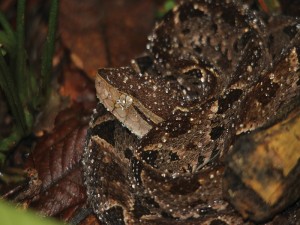
These venomous snakes cause of most ophidian accidents in the country and the rest of Central America. Their identification is of great importance and they are characterized by triangular head shape, well defined scales, and vertical/elliptical pupils (“cat’s eye”). The most relevant feature is the presence of loreal pits (“4 holes or pits” or heat sensors located on the head between the eye and the nostrils). The purpose of the loreal pits is to discover the heat signature of possible prey, which allows the snake to hunt in day or night.
Some of the most famous of Costa Rican viperids are the Fer-de-Lance, the Bushmaster, and the Neotropical Rattlesnake. Their myotoxic and hemotoxic venom destroy tissues and prevents blood from clotting.
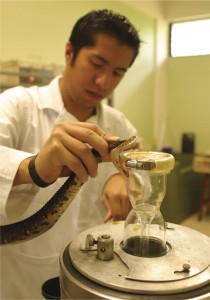
Signs of toxicity from a Viper bite are rapid, and may include the following:
- Severe pain, swelling, bleeding and tissue destruction (necrosis) at the site of the bite.
- Nausea, vomiting, hypotension, excessive sweating, and fever.
- Internal bleeding and blood clotting disorders.
- Cardiovascular shock.
